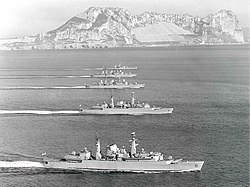Treaty of Joghen
| Treaty of Johghen on Alquiyan-Seketese territorial integrity and peace | |
|---|---|
| Context | 1981 Alquiyan-Seketese crisis Pax Nelbania |
| Signed | December 15, 1981 |
| Location | Joghen, Seketan |
| Expiry | August 1, 1982 by the Treaty of Vlyade[a] March 1, 2006 by the Avro Accords[b] |
| Original signatories | |
| Signatories |
|
| Ratifiers | |
| Languages | |
The Treaty of Joghen was a peace treaty and international agreement signed on 15 December 1981. Its original purpose was to resolve the 1981 Alquiyan-Seketese crisis, but, in conjunction with the Treaty of Vlyade, would go on to form one of the main pillars of Pax Nelbania.
Background
The Treaty of Reykjavik after the Nelborne War established de facto recognition of the Alquiyan-Seketese border and territorial integrity, however, tensions remained high between the two then-authoritarian states over the status of Trjebians and the Rynedan peninsula due to Alquiya's constitution listing the peninsula as part of their sovereign territory. The Nelborne Spring brought democracy to Alquiya and Seketan alongside nationalist zeal, particularly in Alquiya.
In September 1981, Alquiyan Minister of Defense Simion Xrsaza's remarks regarding his government's territory during a routine address to the Alquiyan National Assembly caused concern. The governments of FKT and Seketese perceived his words as a potential threat. Both sides formed crisis committees in anticipation of a possible invasion. Seketan's Foreign Affairs Minister criticized Xrsaza's comments, emphasizing the need to uphold the Treaty of Reykjavik. The press conference led to tension and uncertainty. The crisis escalated as both sides increased military readiness, seeing each other as potential aggressors.
During the night of 16 September 1981, Alquiya sent a naval task force into the Treb Bay alongside an armed mobilization along their border with Seketan. The next morning, Seketan responded in kind with their own mobilization, starting off the crisis. The stand-off would last only 4 days, as the Council of Europe and United Nations brokered an agreement on 21 September for both sides to withdraw their forces and a summit being called for 10 December. The next day, under UN DPKO and CSCE supervision, both sides withdrew their militaries.
Components
The treaty was broken down into 3 main components, territorial integrity, peace, and the establishment of the Nelbec Council. Part 1 and 2 applied only to Alquiya and Seketan, however, would be expanded to the entirety of the Nelbec countries with the Treaty of Vlyade.
Part 1: Territorial integrity
The first component of the treaty was the formal recognition of the border between Alquiya and Seketan as the 1942 peace line. In particular, Alquiya was required to amend its constitution to remove any references to Rynedan.
In 1994, an attempt was made through the Ciloven accords to bring Kingdom of Trjebia (FKT) into the agreement alongside other diplomatic normalization agreements. Dremem, the only remaining portion Trjebia under the FKT's control, was claimed to be part of Alquiya's broader claim over Trjebia, as per a Alquiyan High Court ruling in 1962. The accord ultimately failed, though in 2006 with the signing of the Avro Accords Alquiya formally abandoned all claims over Dremem.
Part 2: Peace
The second portion of the treaty forbade any war, armed conflict, altercation, or military operation between Alquiya or Seketan, with the European Union acting as the guarantor of this peace. The Treaty of Vlyade would expand this principal to the rest of the Nelbec states in 1982.
Part 3: Nelbec Council
The final section of the treaty called for the creation nelbec forum to resolve disputes and conflicts before they escalated into crises. A second conference of all Nelbec nations would be called for 15 July 1982 in Vlyade, Lormotia. On 1 August 1982, the Treaty of Vlyade was signed by Alquiya, Lormotia, Seketan, and the Seketese province Wilskland[c], expanding the components of the Treaty of Joghen and creating the Nelbec Council.
Notes
- ↑ The Treaty of Vlyade creates the Nelbec Council, which the Treaty of Joghen outlined as necessarycomponent for its ratifacation
- ↑ Created the Nelborne Union, a pillar of Pax Nelboria
- ↑ Wilskland is nominally a province of Seketan, though constitutionally they are an "Independent State", and have been afforded special autonomy regarding certain issues

